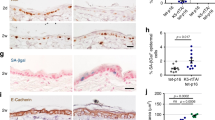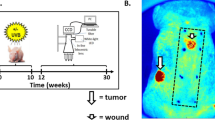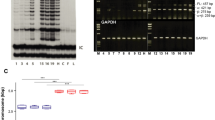Abstract
The discovery of a two-stage mechanism of Carcinogenesis in mouse skin, with initiation and promotion as independent components, provided new approaches to the study of the development of neoplasms in experimental animals and humans1–5. However, it is not clear how the carcinogen and promoting agent are involved at different steps in the development of papillomas and carcinomas. Here we have used cell markers in mice to study the mechanism of development of papillomas induced by the classical method of two-stage skin tumorigenesis (initiation with subtumorigenic doses of a carcinogen followed by promotion with phorbol esters) and by multiple treatments with initiating doses of a carcinogen. Our results show that papillomas induced by repeated carcinogen applications arise from significantly more cells than those induced by the carcinogen-promoter regimen.
This is a preview of subscription content, access via your institution
Access options
Subscribe to this journal
Receive 51 print issues and online access
$199.00 per year
only $3.90 per issue
Buy this article
- Purchase on Springer Link
- Instant access to full article PDF
Prices may be subject to local taxes which are calculated during checkout
Similar content being viewed by others
References
Berenblum, I. in Cancer: A Comprehensive Treatise Vol. 1 (ed. Becker, F. F.) 323–344 (Plenum, New York, 1975).
Boutwell, R. K. Prog. exp. Tumor Res. 4, 207–250 (1964).
Stenback, F., Garcia, H. & Shubik, P. The Physiopathology of Cancer Vol. 2, 155–225 (1974).
Scribner, J. D. & Suss, R. Int. Rev. exp. Path. 18, 137–197 (1978).
Farber, E. Am. J. Path. 106, 271–296 (1982).
Reddy, A. L. & Fialkow, P. J. J. exp. Med. 150, 878–887 (1979).
Woodruff, M. F. A. et al. Nature 299, 822–824 (1982).
Scribner, J. D. & Scribner, N. K. in Carcinogenesis Vol. 7 (eds Hecker, E. et al.) 13–18 (Raven Press, New York, 1982).
Della Porta, G. et al. J. natn. Cancer Inst. 25, 573–605 (1960).
Stenback, F. Acta path. microbiol. scand. Suppl. 208 (1969).
Verma, A. K., Conrad, E. A. & Boutwell, R. K. Carcinogenesis 1, 607–611 (1982).
Verma, A. K., Conrad, E. A. & Boutwell, R. K. Cancer Res. 42, 3519–3525 (1982).
Author information
Authors and Affiliations
Rights and permissions
About this article
Cite this article
Reddy, A., Fialkow, P. Papillomas induced by initiation–promotion differ from those induced by carcinogen alone. Nature 304, 69–71 (1983). https://doi.org/10.1038/304069a0
Received:
Accepted:
Published:
Issue Date:
DOI: https://doi.org/10.1038/304069a0
This article is cited by
-
The role of mutation in the new cancer paradigm
Cancer Cell International (2005)
-
Selective clonal expansion and microenvironmental permissiveness in tobacco carcinogenesis
Oncogene (2002)
Comments
By submitting a comment you agree to abide by our Terms and Community Guidelines. If you find something abusive or that does not comply with our terms or guidelines please flag it as inappropriate.



